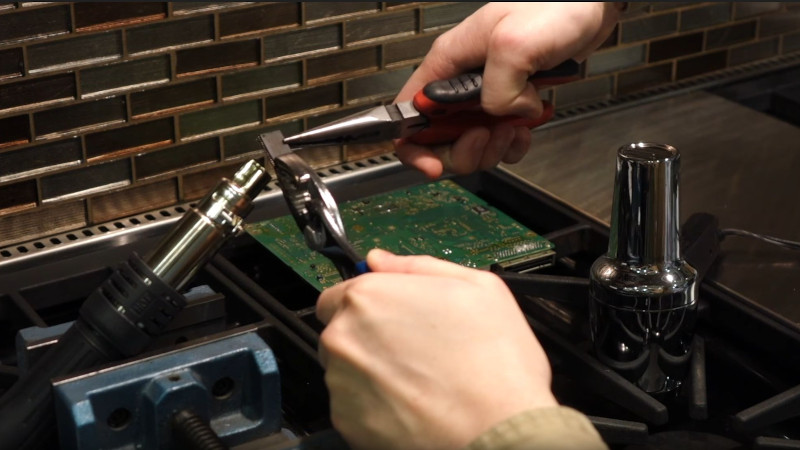While repairing a real-time clock module for a 1970s HP computer that had been damaged by its leaky internal battery, [CuriousMarc] began to suspect that maybe the replacement clock chips which he had sourced from a seller in China were the reason why the module still wasn’t working after the repairs. This led him down the only obvious path: to decap and inspect both the failed original Ti chip and the replacement chip.
The IC in question is the Texas Instruments AC5948N (along with the AC5954N on other boards), which originally saw use in LED watches in the 1970s. HP used this IC in its RTC module, despite it never having been sold publicly. This makes it even more remarkable that a Chinese seller had the parts in stock. As some comments on the YouTube video mention, back then there wasn’t as much secrecy around designs, and it’s possible someone walked out of the factory with one of the masks for this chip.
Whether true or not, as the video (also included after the break) shows, both the original 1970s chip and the China-sourced one look identical. Are they original stock, or later produced from masks that made their way to Asia? We’ll probably never know for sure, but it does provide an exciting opportunity for folk who try to repair vintage equipment.
















There is no reason anybody would obtain the original masks to produce new chips as obscure as these. The fact that this was available from Chinese suppliers, just means that they were probably removed from boards received for recycling. Unfortunately they were probably removed from boards that had stopped working, for the reason their original chip failed, as stated at the beginning of the video, i.e., that when the batteries fail, the charging circuit goes to its rails and blows the chip. So yeah, genuine chips, genuinely failed.
I’d also put my money on recycled chips, but maybe with a less negative spin.
Sure, this one chip could be the reason that the device failed, but given that it could also be any number of other parts, I’d say your odds of getting a working one are actually OK.
If you need four, just order ten…
Well, yeah, that usually works, but if this chip was only ever used on that product, and that product ALWAYS self-destructed when the battery went dry, then the only way you’d ever get a good chip was if it was never powered up after the battery failed. My understanding from the video was that the failure mode was that once the battery became effectively an open circuit, there was nothing to limit the voltage from the charging circuit, and it invariably fried the clock chip.
Of course, I’m making the same assumption that [CuriousMarc] does, that it is the clock chip itself that failed. It doesn’t seem all that likely to me that 5 V would damage such a chip. I know that it was an early 1970s chip made to be powered from maybe 3 V, and they weren’t real big on protecting inputs from even slight overvoltage, and the chip was after all designed to be put in cheap watches. BUT, I’m not completely convinced by the video that [CuriousMarc] has ruled out everything else. It seems like it went something like, “well, here’s the rechargeable RTC battery with its guts on the outside, and it connects to this, which must be the RTC chip. Let’s see if we can find a replacement chip”, and down the rabbit hole we go, and before you know it, we’re comparing dice under a microscope instead of troubleshooting electronics.
@BrightBlueJim: This is obviously not how it went. The failure was narrowed down to the clock chip not working – the rest of the circuit works. And these chips will die when directly connected to 5V – all of them, no exception. Although it could be something else in the oscillating circuit that’s wrong, there is just a crystal and a few pF cap, these are the only two external components around the clock chip. That these two would fail on two different boards is unlikely, although it has not yet been ruled out.
Stuff I’ve seen, but I’ve by no means seen it all, is such that even 5 years later copies after the mid 70s, the copy would be die shrunk, because using that much area of silicon left a lot of money on the table by the time the processes had had a few shrinks.
recycled most likely and TI chips not HP ..they are in an HP module!!
If you watch YT you can bypass HAD by several days/weeks
I find it quite staggering that the best solution the HP engineers could come up with was to package a wristwatch chip /and/ add all that extra logic to simulate the button presses and decode the muxed 7 segment display output. Surely designing the RTC function from scratch in off the shelf 4000 series CMOS logic would have been easier for them?
The software design for all of this functionality is in a chapter “Bucky’s Wristwatch” in Ted Nelson’s “Computer Lib / Dream Machines” – also published in the 1970’s. They could have just cribbed it from that!
You have to remember that the world was not the open forum of ideas that it is today. In those days, we had periodicals that told us about the latest components on the market, and if we saw something we liked, we’d order the datasheet or databook from the manufacturer. So to “crib” someone else’s design, you first had to hear about it somewhere, to even know that it existed, and then somehow obtain a schematic of it, or get an example of the product itself to reverse engineer it from. Expecting that the engineer tasked with designing an RTC for this instrument, would have read the specific book you’ve seen, is a bit much.